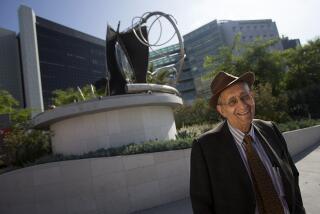Sculptor’s Capital Idea Throws a Curve at D.C.
WASHINGTON — No one could complain that official Washington is too disorderly. The Mall, and the avenues and numbered streets and tidy circles that branch off it, are in such good trim they nearly contradict democracy’s fertile mess. In one largely unnoticed corner of Washington’s rule-boundedness, however, some wonderful new art has come to stir things up.
Two years ago, the National Gallery commissioned veteran abstractionist Frank Stella to work up an outdoor sculpture, his largest ever. During the last few months, some of us have watched it come together on the far northeastern corner of the gallery’s site. (It turned out too big and strange to play well with other works in the official sculpture garden two blocks to the west.) “Prinz Friedrich von Homburg, Ein Schauspiel, 3X,” as it’s titled--don’t bother asking why; just shorten it to “Prince of Homburg”--sits smack in line with the Capitol and seems almost to be thumbing its nose at all those ranks of regimented columns.
It’s a 10-ton, 40-foot tangle of spiky aluminum, sparkling white fiberglass swoops and messy carbon-fiber swirls. You could say that it’s all and only thumbs and noses, without a ramrod back in sight.
Most public buildings, and the art that sits in front of them, seem to declare what they’re all about: The buildings mark their entrances and exits, their various levels and component parts, to be as legible as possible. Their artworks do the same, sitting proud atop their pedestals with fronts and sides and backs conceived to greet the likely streams of visitors that will approach them. Whether it’s a long-forgotten general on horseback or a biomorph by Henry Moore, the same tidy grammar governs the language that they speak. Our new Stella, however, keeps things much more off-balance than that. It speaks in tongues.
The thing floats some eight feet off the ground, for one thing, held up by a slew of steel trusses and guy wires that run through and into and all around the sculpture’s more substantial bits. It isn’t just that there’s no pedestal for it to sit on--pedestallessness has been the rule in vanguard art for many decades now. It’s that you cannot tell what counts as holder, and what’s holdee.
Those wires are both support and sculptural component part. (While the sculpture was being built, various cranes and hoists were gathered around it; as work progressed and came to completion, it was hard to tell if there were still a few left to remove, or if what was left was every bit artwork.) The tensioned straightness of the work’s support network has nothing much in common with the baroque curls it helps to steady, but that mismatched variety is one of this sculpture’s most winning traits. I dare anyone to summarize what shape it is without abarrage of hand gestures. It’s all frantic, incoherent gesture, in fact, with hardly any simple declaration of what it’s all about.
Or tell me simply, please, what our “Prince of Homburg” is made of.
There’s shiny metal, sliced to look like twisted scraps from old tin cans. Imagine a starry comic-book explosion that’s been Exacto-ed off the page, stretched wide like Silly Putty, then made to almost loop round on itself.
Then there’s all that bright white fiberglass, floating in the air alongside Stella’s sparkling shards. It looks as though the artist began to shred a massive sheet of paper, changed his mind halfway, pulled free what was left in the shredder, then halfheartedly began to twist it into a Mobius strip. A one-armed giant trying to craft a homemade Chinese lantern might end up with something similar.
Finally there are the carbon swirls, mostly black, with distressed splats and weathered flashes of dull pink dancing across them. They look like remnants of a whitewall-tire blowout still flying through the air. Or a Disney image of a caldron’s twisting plume of smoke about to turn into a spooky demon.
Confused about what this thing might look like? Good. Confusion and inchoate rush are, I think, the keys to what makes this sculpture seem so special--even though it’s “just” another in the line of abstract modern forms that goes back to the 1920s.
More to Read
The biggest entertainment stories
Get our big stories about Hollywood, film, television, music, arts, culture and more right in your inbox as soon as they publish.
You may occasionally receive promotional content from the Los Angeles Times.










